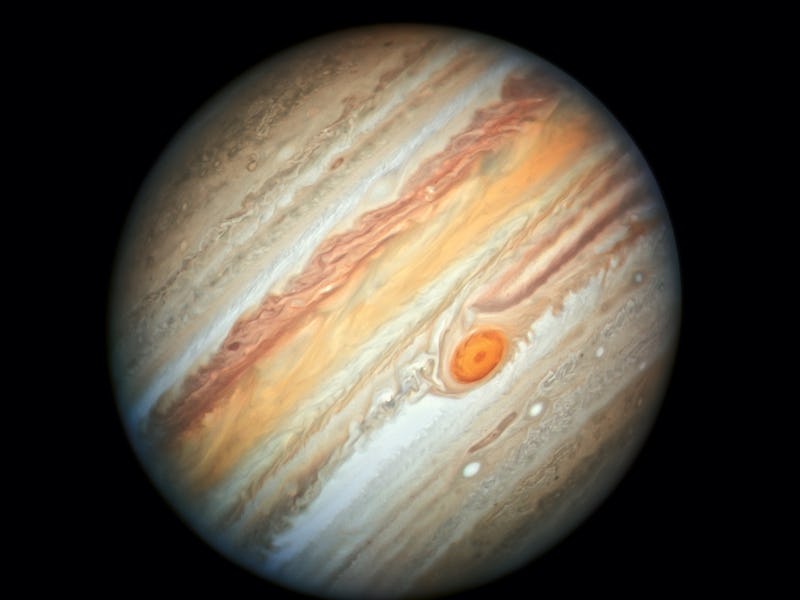Webb Telescope Makes a Pair of Intriguing Discoveries About Jupiter’s Moons
This is what happens when two very different moons are on the receiving end of Jupiter’s might.

Astronomers continue to make new discoveries about the Galilean moons of Jupiter, a thrilling environment of ice and fire.
In a pair of studies published this month, the James Webb Space Telescope (JWST) probed two famous moons around the gas giant. Ganymede and Io are one-half of the Galilean moons, discovered by Galileo Galilei in the 17th century. They’re quite different from one another: Ganymede is icy, and Io is volcanic. But both are on the receiving end of Jupiter’s mighty influence.
The telescope found evidence that the bombardment of charged particles from Jupiter can manipulate the ice at Ganymede’s poles. It also observed the first “forbidden” emission line for Io’s volcanic eruptions.
Two studies detail the work, one published in the journal Science Advances, and the other in the journal JGR Planets.
What did they find on Ganymede?
A composite image of Jupiter’s Galilean moons. From left to right: Io, Europa, Ganymede and Callisto.
Ganymede, the largest moon in the Solar System, has a magnetic field — something many other moons and even some planets lack. Worlds with magnetic fields, like Earth for instance, direct charged particles in space along the field’s lines towards the poles. The end of this journey produces auroras. In the case of Ganymede, something else happens too — there’s a breakdown of its water ice molecules. The giveaway was the telescope’s detection of hydrogen peroxide at the Ganymede poles.
“JWST revealing the presence of hydrogen peroxide at Ganymede’s poles shows for the first time that charged particles funneled along Ganymede’s magnetic field are preferentially altering the surface chemistry of its polar caps,” according to Samantha Trumbo, lead researcher on the Ganymede paper and 51 Pegasi b postdoctoral fellow at Cornell University. Trumbo gave comments in a statement published Thursday describing the Jovian science.
Hydrogen peroxide, or H2O2, is a water molecule with an extra oxygen atom. It forms at Ganymede’s poles after Jupiter sprays highly charged particles into space. When they bombard Ganymede, the moon’s magnetic field directs them to the northern and southern poles. There, the Jovian particles slam into the polar ice and break apart its ice molecules. When some of it recombines, hydrogen peroxide forms.
This is called water radiolysis. Trumbo says it's likely common to icy objects throughout the Solar System. “We really want to understand this process, how it works, and what the primary controls are, because it is so important and widespread,” Trumbo tells Inverse.
In the case of Europa, another Galilean moon, water radiolysis could answer questions about its habitability. Europa may host a subsurface ocean beneath an icy crust, where pressures and conditions might support microbial life. Missions like NASA’s Europa Clipper will soon visit the moon to get a handle on its intrigue.
What did they find on Io?
Io isn’t icy — it’s volcanic. Jupiter is hefty, and as a result, it wields a powerful gravitational pull. This has a push-and-pull effect on Io. The result is ongoing volcanic activity, and as astronomers seek more information about these eruptions, they come across roadblocks.
One was lifted recently, when astronomers found a “forbidden” emission line. The telescope peered at Io when the moon was in Jupiter’s shadow. This isolated data from one sort of sulfur molecule and another. When sensitive telescope instrumentation detected the faint emission of one molecule in particular, sulfur monoxide (SO), which appeared because Jupiter’s shadow had brought most of the obscuring molecule sulfur dioxide onto Io’s surface, astronomers knew they had caught an eruption from a stealthy volcanic vent in the distant Solar System.
JWST measurements on the left show thermal data of a very active volcanic area called Kanekehili Fluctus on Io. On the right, “forbidden” emissions appear from sulfur monoxide (SO). This regional coincidence confirms the theory that SO is a marker for active volcanic vents.
“The only way we could explain this emission is if the SO is excited in the volcanic vent at a temperature of 1,500 Kelvin [2,240 degrees Fahrenheit] or so, and that it comes out in this excited state, loses its photon within a few seconds, and that is the emission we see,” shares Imke de Pater, co-principal investigator of the observation team that conducted this research during JWST’s Early Release Science program. de Pater, who is also the lead author of the Io paper, shared comments in the statement.
The big picture
The Galilean moons are one of the most fascinating places in the universe for modern astronomers. Whether scientists are on the hunt for extraterrestrial life, or curious about our cosmic neighborhood in its extremes, Jupiter delivers.
NASA’s Europa Clipper is currently in development, slated to launch in October 2024. The European Space Agency’s JUICE mission, short for Jupiter Icy Moons Explorer, launched in April to explore the Galilean moons in-depth.
This article was originally published on